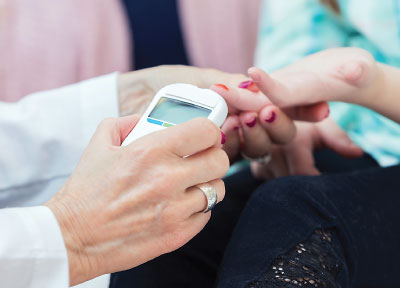Type 2 Diabetes Risk in Youth Using SSRIs Appears Lower Than Previously Reported
Abstract
Adolescents who are overweight or obese or who have additional risk factors for type 2 diabetes should be screened with a fasting blood glucose level or a hemoglobin A1C level test before initiating an SSRI.

Biomarkers may be helpful in determining which patients may be responsive to different drugs. —Lon S. Schneider, M.D.
The risk of developing type 2 diabetes (T2D) among youth who take selective serotonin reuptake inhibitors (SSRIs) may be lower than previously reported, new research suggests.
The findings were published online September 2 in JAMA Psychiatry by Jenny W. Sun, Ph.D., now a postdoctoral research fellow at Harvard Medical School and Harvard Pilgrim Health Care Institute in Boston, and colleagues.
The data, from a cohort study of more than 1.5 million youth aged 10 to 19 with a diagnosis for an SSRI treatment indication, suggest that there is a small increased risk for T2D among those prescribed SSRIs, particularly among youth with public health insurance. However, the increased risk compared with non-SSRI users was lower than that found in a similar study from 2017 (see Psychiatric News).
Moreover, the absolute risk was low, amounting to an additional 6.6 cases per 10,000 patients continuously treated for at least two years.
“The new study is reassuring in the sense that it suggests the risks of type 2 diabetes from SSRIs may be lower than previously assumed based on earlier research. Nevertheless, adolescents who are overweight or obese or who have additional risk factors for type 2 diabetes should ideally be screened with a fasting blood glucose level or a hemoglobin A1C level before initiating an SSRI,” study co-author Mark Olfson, M.D., M.P.H., the Dollard Professor of Psychiatry, Medicine, and Law at Columbia University, told Psychiatric News.

The study reduces, but does not eliminate the concern that use of SSRIs may increase the risk of developing type 2 diabetes in children and adolescents, says Mark Olfson, M.D., M.P.H.
Olfson said that the 2017 paper, which also looked at serotonin-norepinephrine reuptake inhibitors (SNRIs) but was limited to the Medicaid population, “drew attention to risks of T2D in young people treated with SSRIs or SNRIs, especially among young people treated with higher doses over longer periods. One reason that the difference in risk is lower in our study … may be the more rigorous methods we used to control potential confounders between study groups.”
The prior study had generated concern among child psychiatrists and pediatricians. Now, “the new study reduces but does not eliminate this concern,” Olfson said.
Depression Itself a Risk for T2D
Philip S. Zeitler, M.D., a professor and head of pediatric endocrinology at the University of Colorado Anschutz Medical Campus, who was not involved in the study, was asked to review it for Psychiatric News. He pointed out, “There is a strong relationship between depression and type 2 diabetes, and this makes it difficult to tease apart medication from depression as the association with diabetes. We see a lot of depression in our kids, and that’s a known association [with diabetes] in both kids and adults. But in fact, it’s the minority of kids who actually get treated with medication because of the weaknesses of mental health care in our country.”
And because so few children and adolescents get treatment for depression, “it’s more common for us to make the diagnosis of depression and anxiety because we screen for it because of the known association,” noted Zeitler, who also chairs the Department of Endocrinology at Children’s Hospital Colorado. “So, it’s more common for us to get the patients started on an SSRI than for them to come in on medication.”
Olfson and colleagues analyzed data from the 2000 to 2014 Medicaid Analytic eXtract (MAX) database on 316,178 publicly insured patients who initiated SSRI treatment and 632,356 who did not, as well as data from the IBM MarketScan database from January 1, 2003, to September 30, 2015, on 211,460 privately insured SSRI initiators and 422,920 age-matched non-initiators. They also conducted a secondary analysis comparing new SSRI users with those initiating bupropion hydrochloride and psychotherapy.
Those using SSRIs were more likely to be female and white, and they had more diagnoses and medication use for psychiatric and nonpsychiatric conditions. There were no differences in markers for obesity and metabolic conditions.
Among the publicly insured patients, after about two years’ follow-up, the unadjusted incidence rate of T2D was 2.32 cases per 1,000 person-years for those initiating SSRIs versus 1.65 cases per 1,000 who did not, with a significant crude hazard ratio of 1.39. After adjustments for baseline differences, the hazard ratio dropped to 1.13, although it remained significant.
Among those who continued SSRI treatment for at least 30 days, adjusted hazard ratios were 1.33 at two years, suggesting that 1,515 patients would need to be treated for two or more years for one patient to develop T2D.
Absolute T2D rates were lower in the privately insured group, and the difference between those using and not using SSRIs was not significant.
There was no significantly increased risk for T2D among the two groups; however, there was an increased risk compared with psychotherapy among the publicly insured group (hazard ratio 1.44).
The 2017 study data aren’t directly comparable to these, but they definitely reflected a higher risk, with an adjusted relative risk for T2D of 1.88 for current compared with former users of SSRIs or SNRIs. The absolute risks, however, weren’t very different: 1.55 per 1,000 person-years among current SSRI/SNRI users in the previous study versus 1.32 per 1,000 person-years in the continuous treatment analysis in the publicly treated current study, Olfson noted.
SSRI-Related Weight Gain May Mediate Risk
Weight gain with SSRIs is one possible mechanism for the association, Olfson said. “As their depressive symptoms resolve, some depressed patients experience increased appetite, especially with longer-term SSRI treatment.” The claims data did not allow for a reliable assessment of weight gain, he noted.
Zeitler noted that the retrospective nature of both studies introduces potential confounding. “It’s not possible to fully understand what biases have been introduced due to inaccurate or incomplete data entry. Diabetes and metabolic screening practices are not standardized in kids, and it’s quite possible that kids given prescriptions were screened more aggressively or differently.”
Moving forward, Olfson said, “Challenges for the field involve identifying patient characteristics that place young people at increased risks of antidepressant-associated diabetes and elucidating how these risks vary across individual antidepressant medications.” ■



